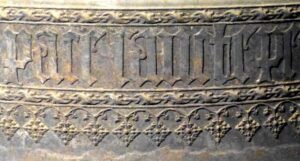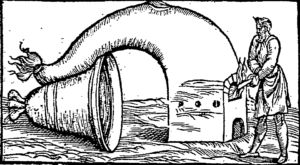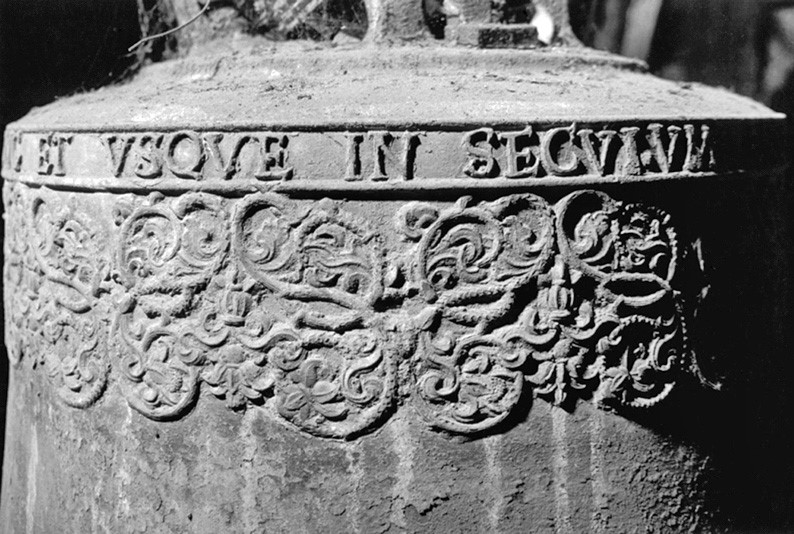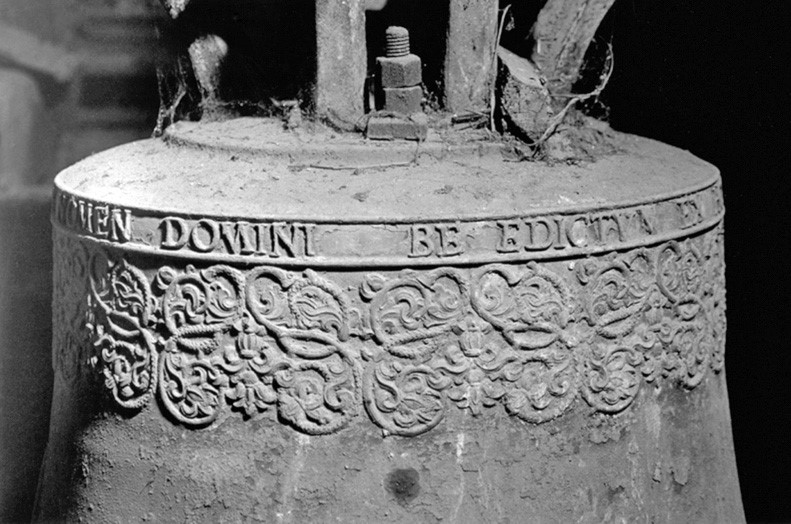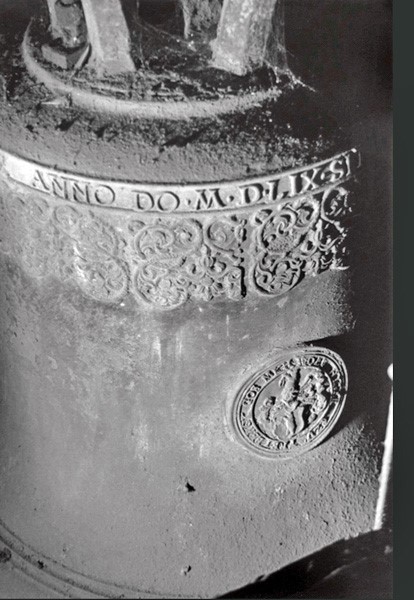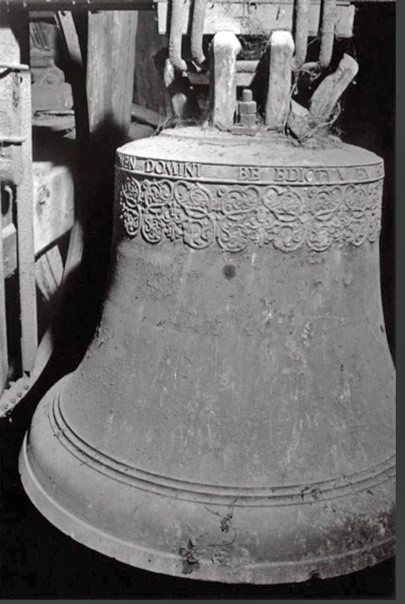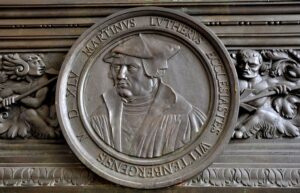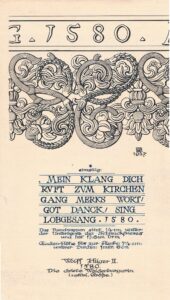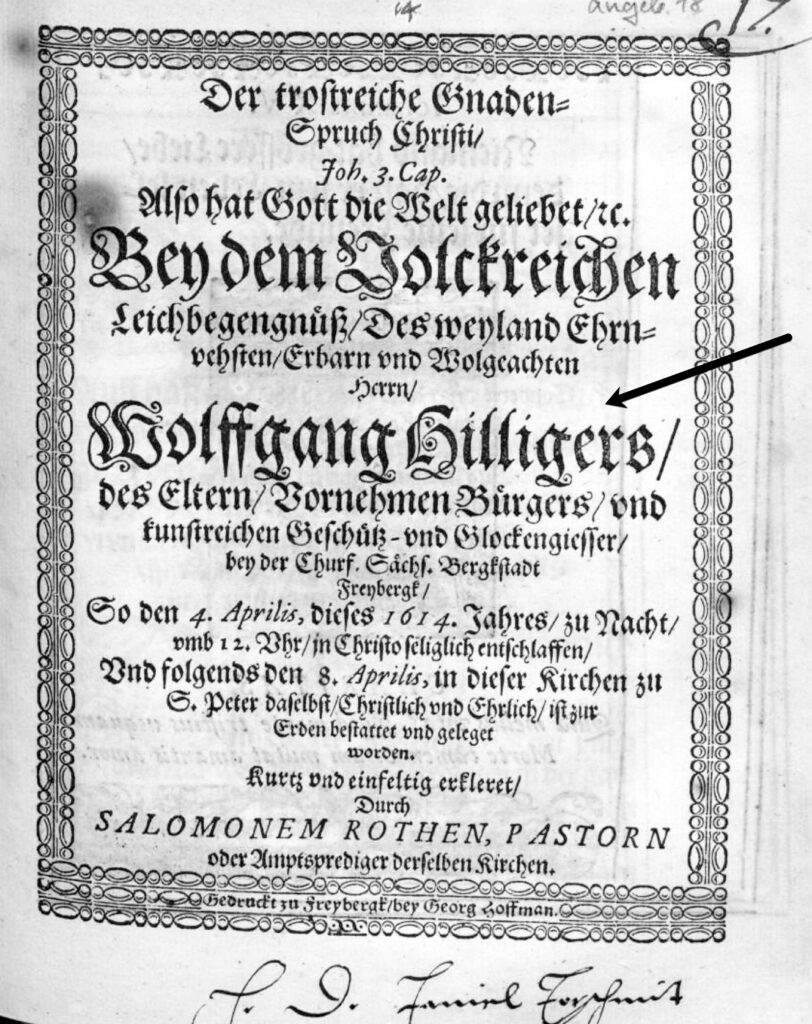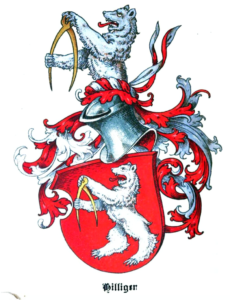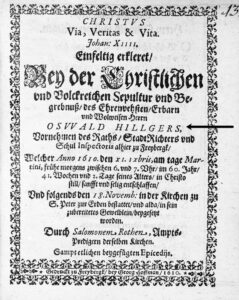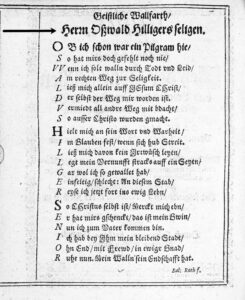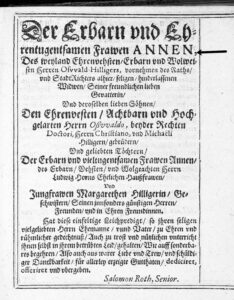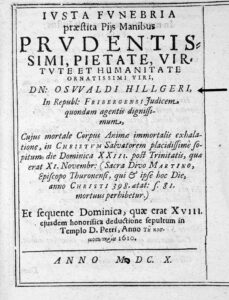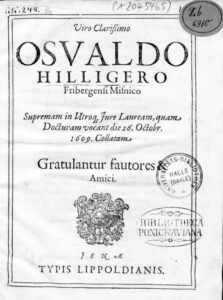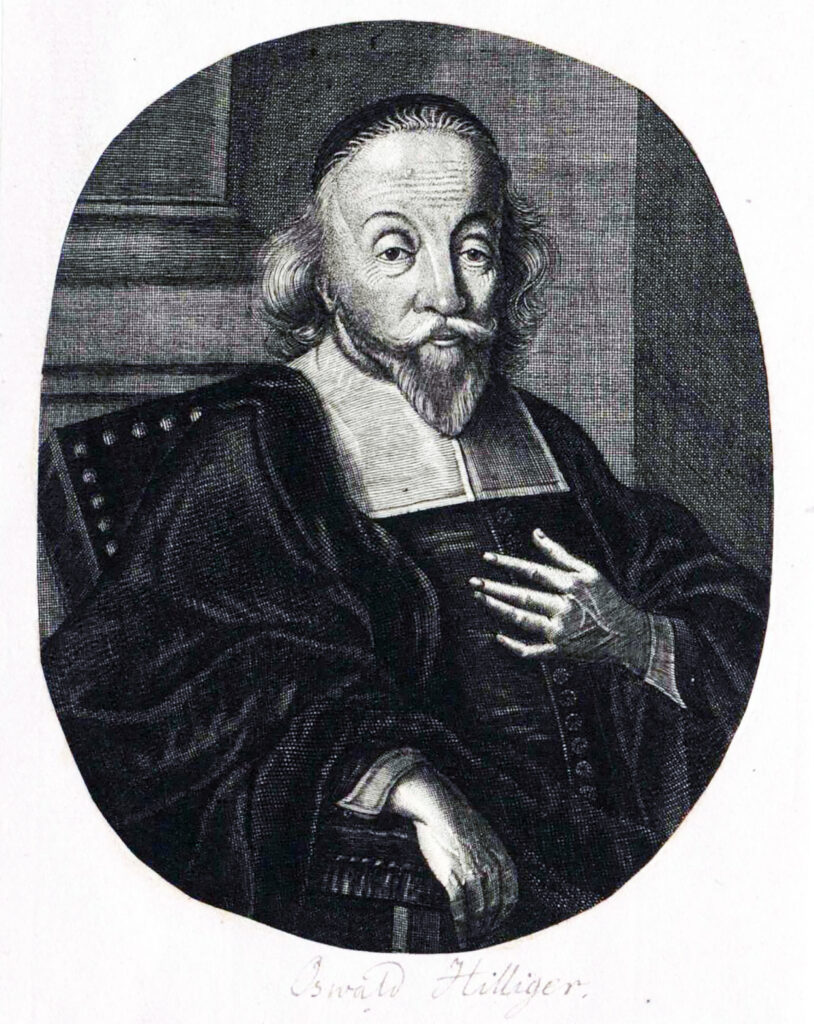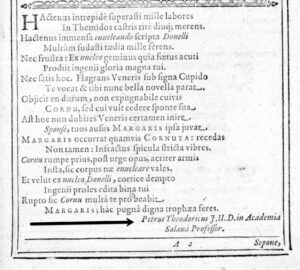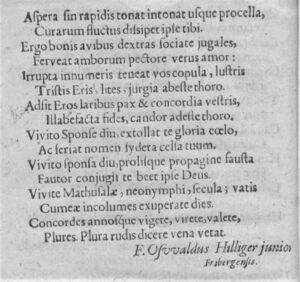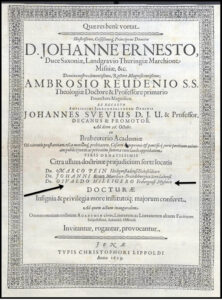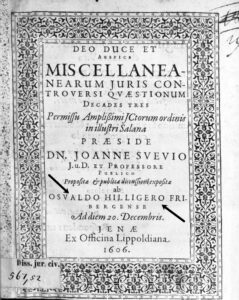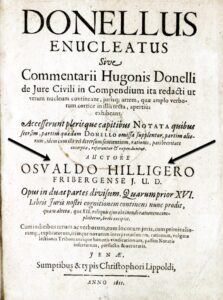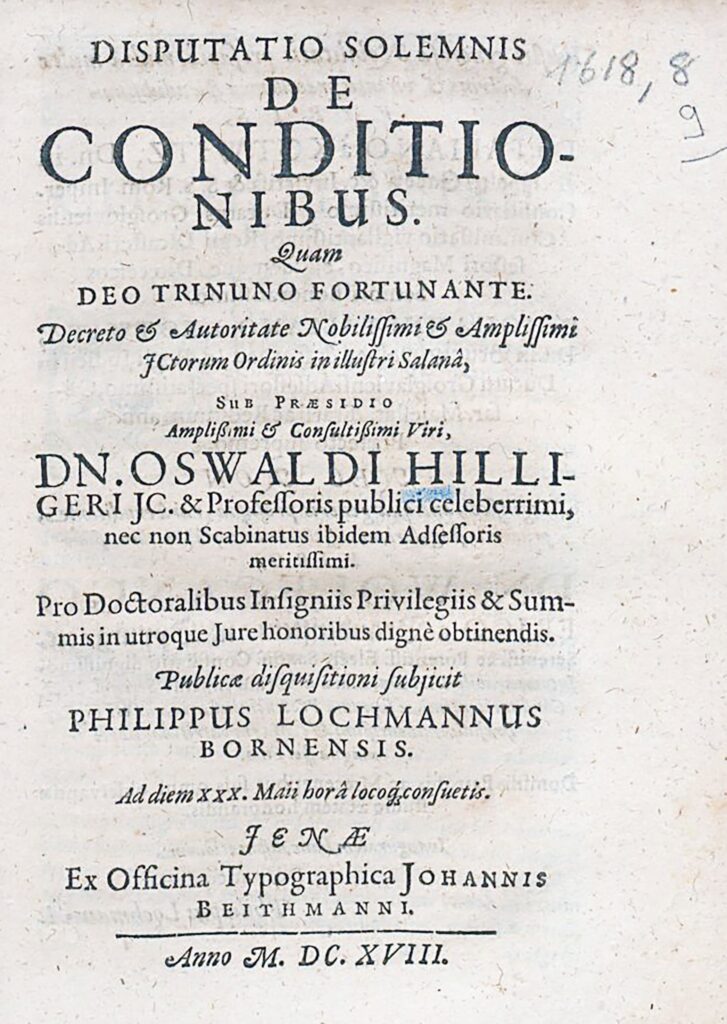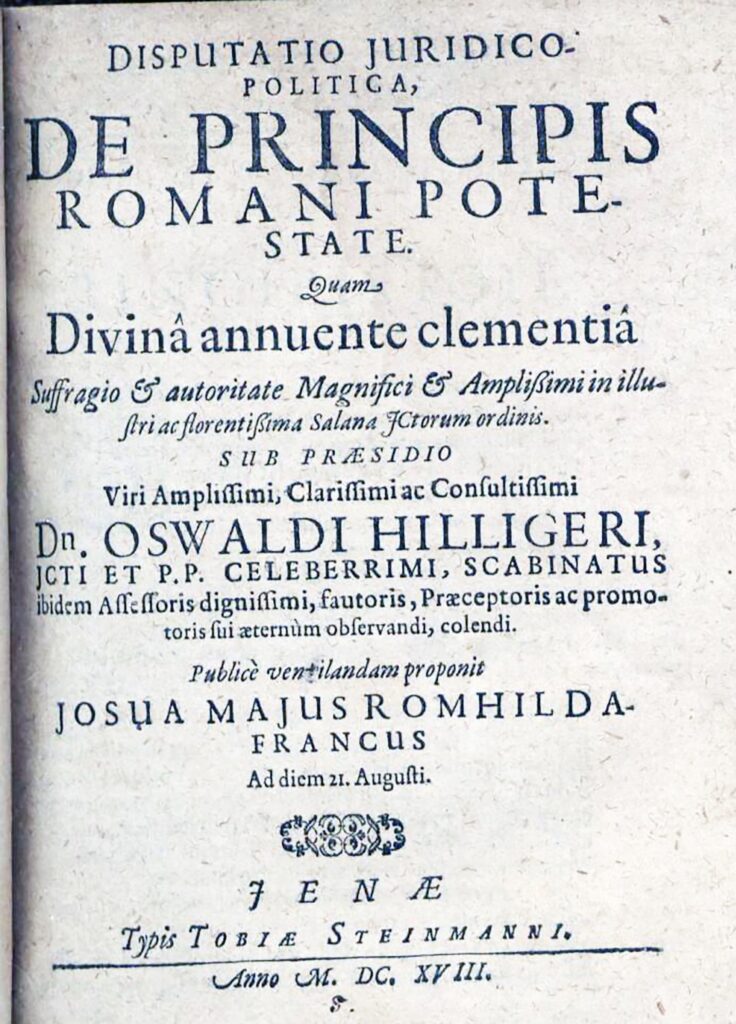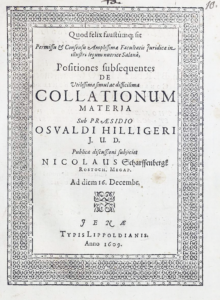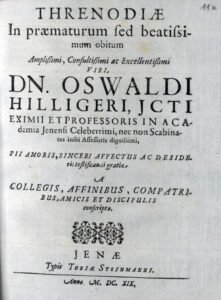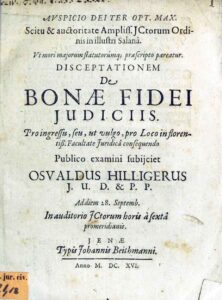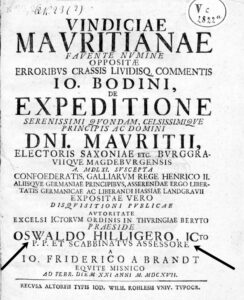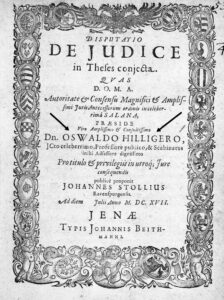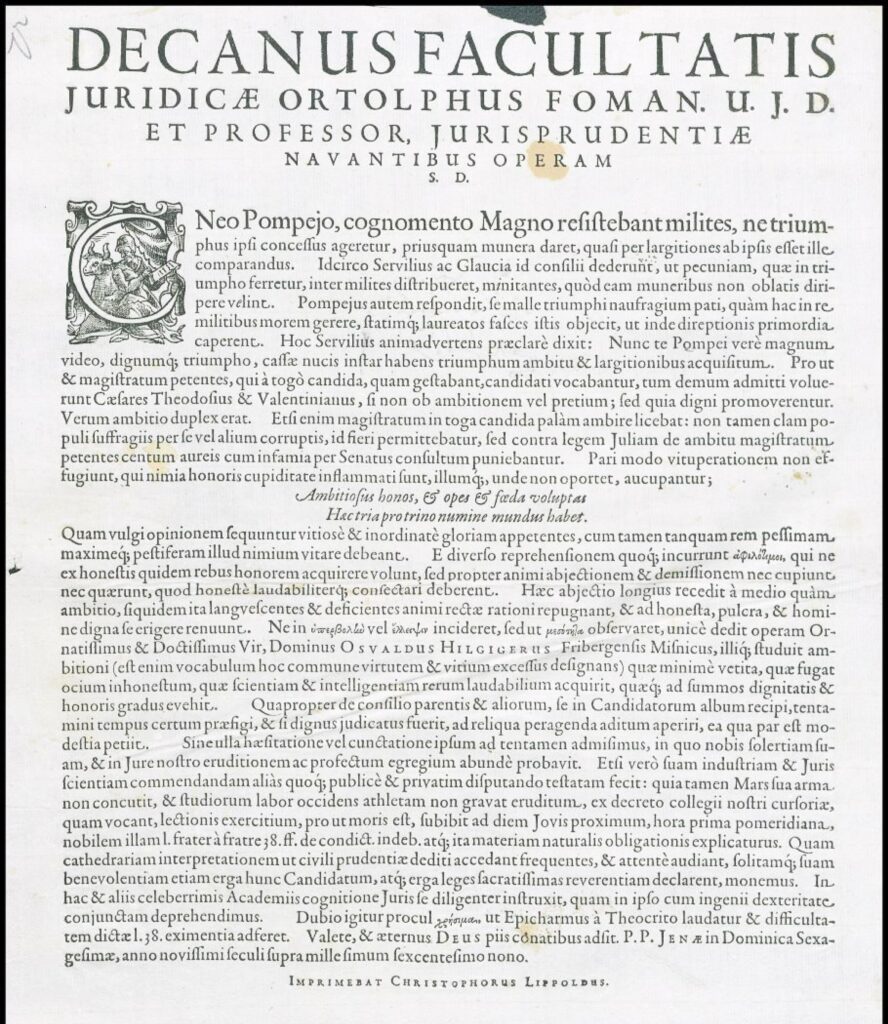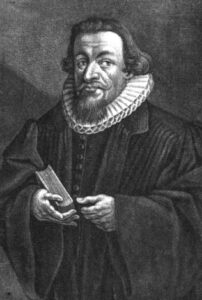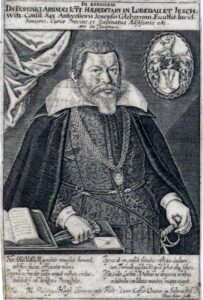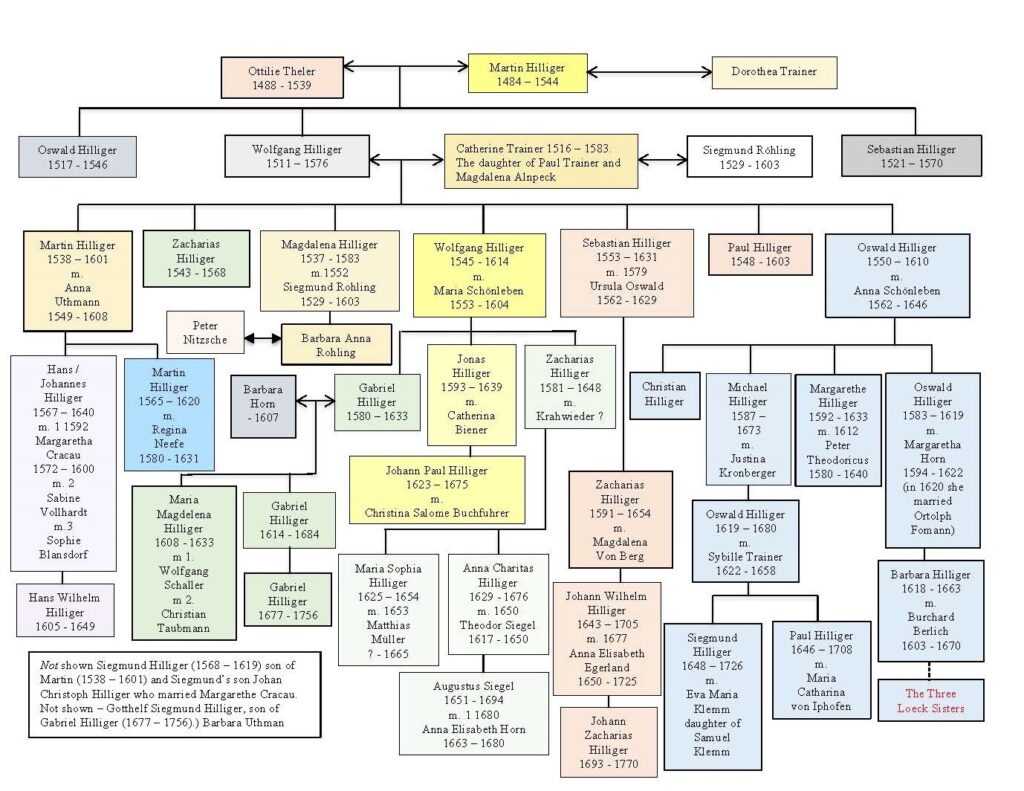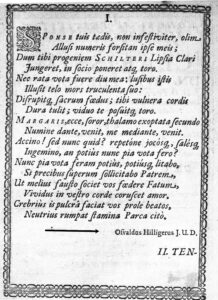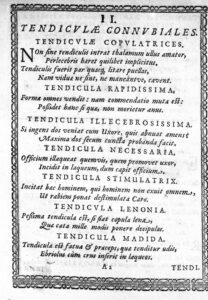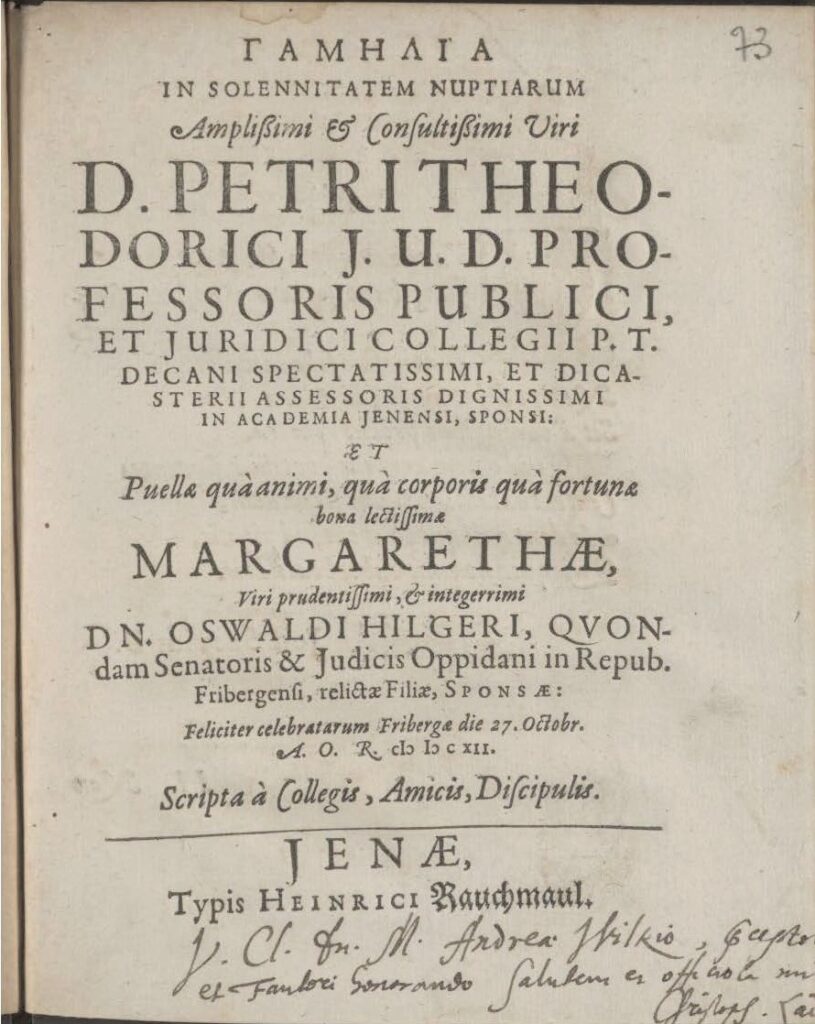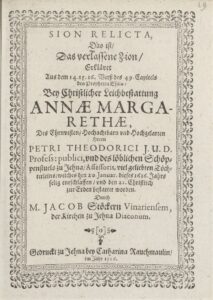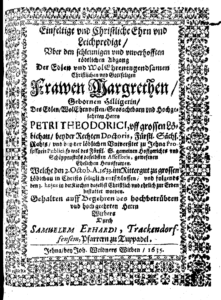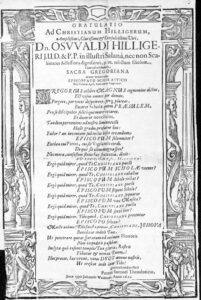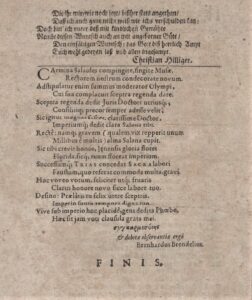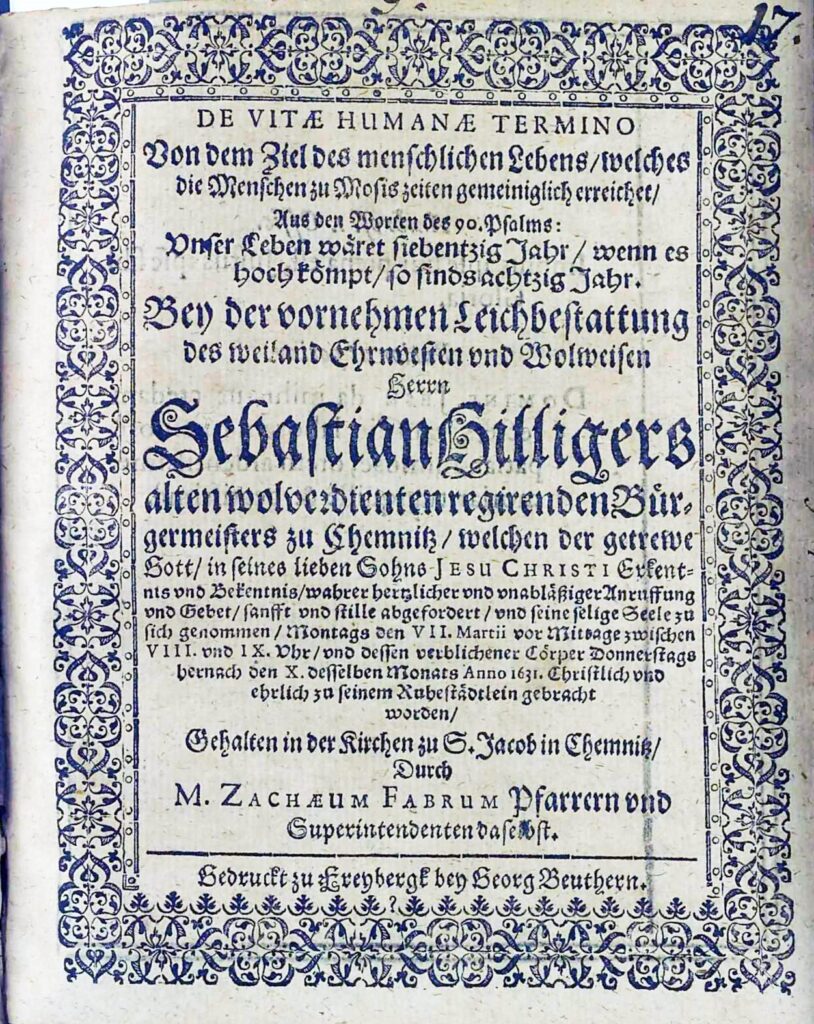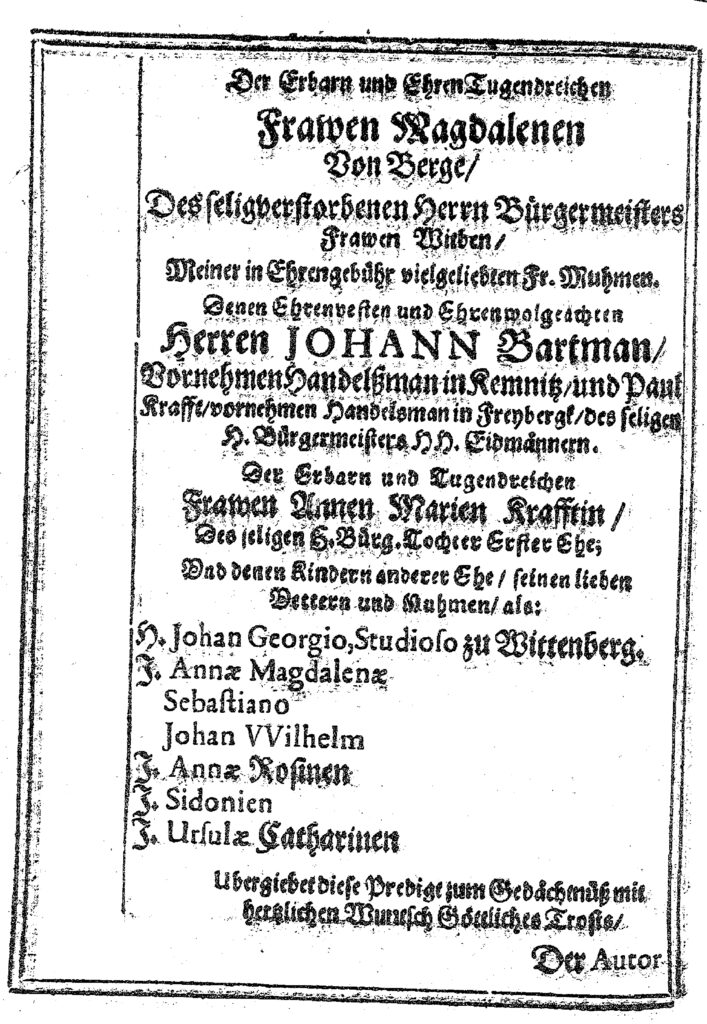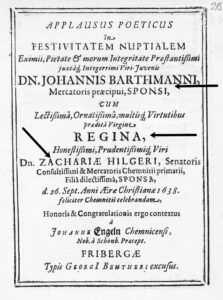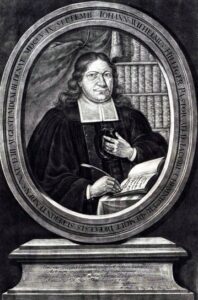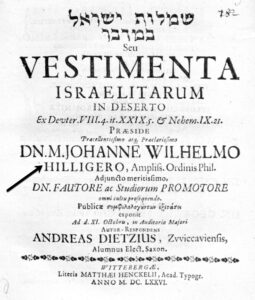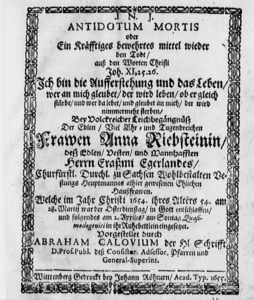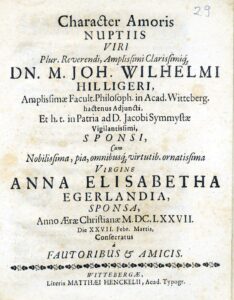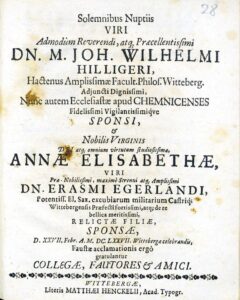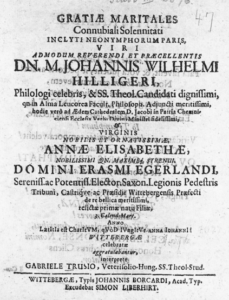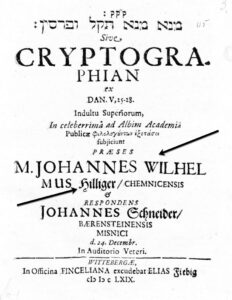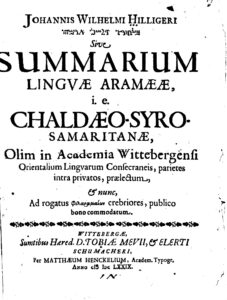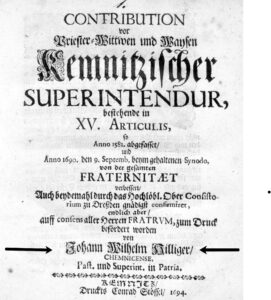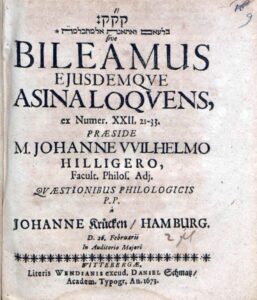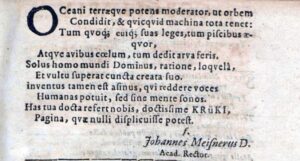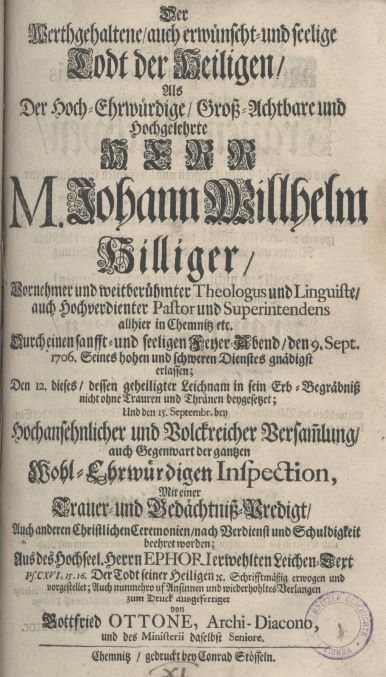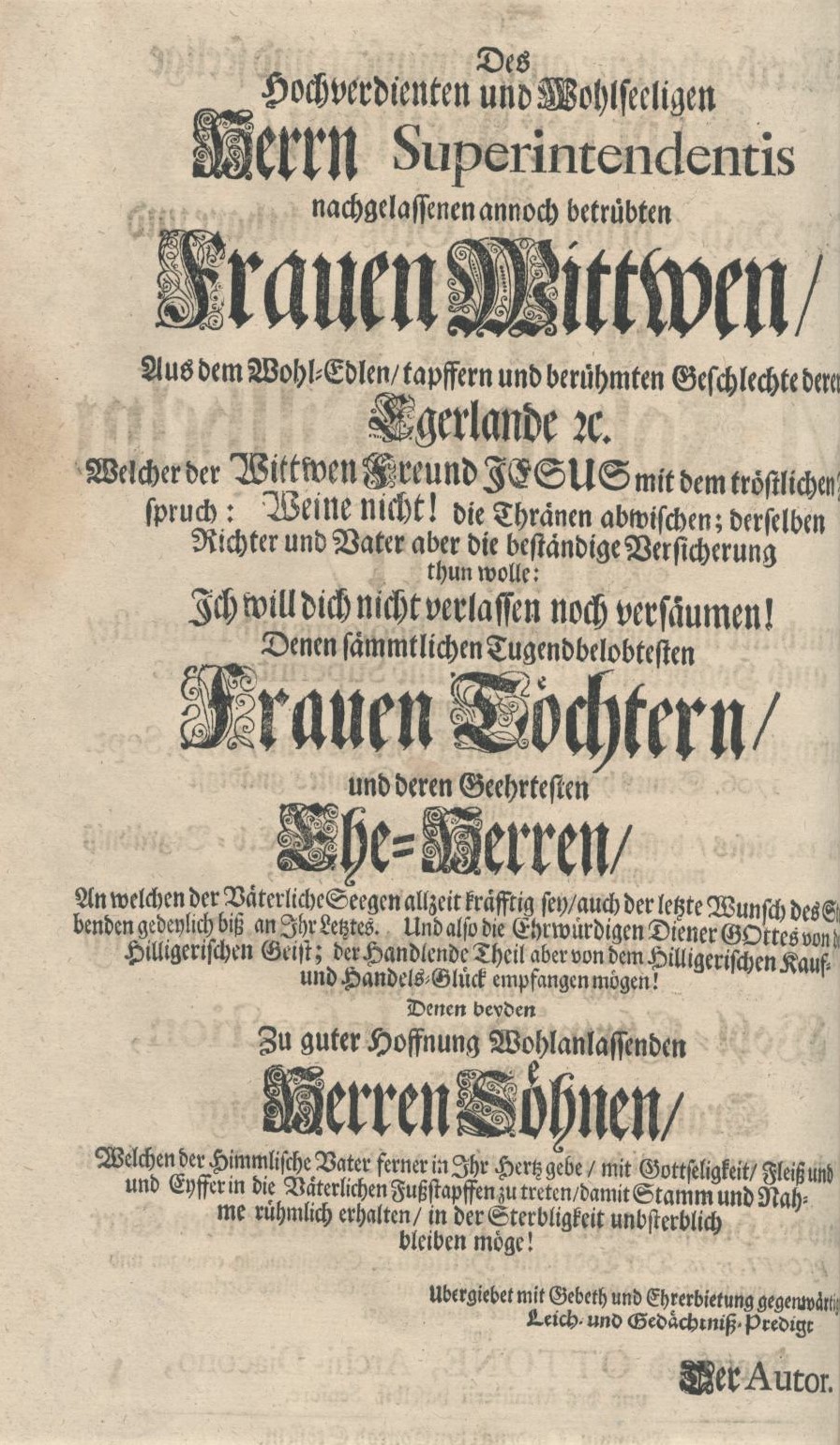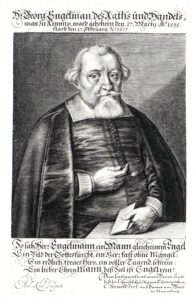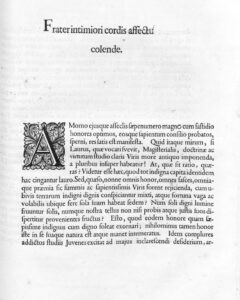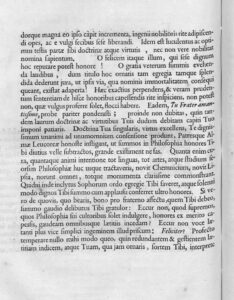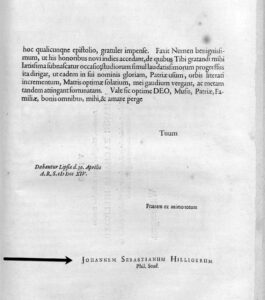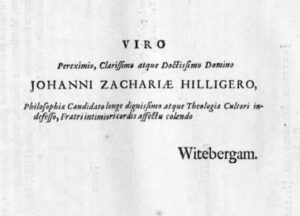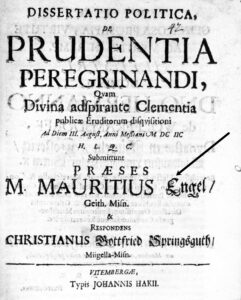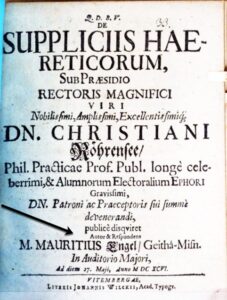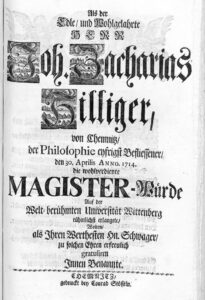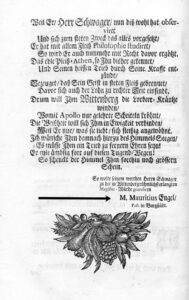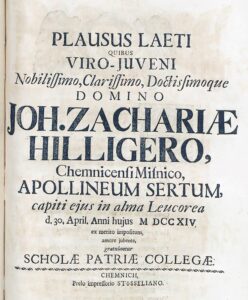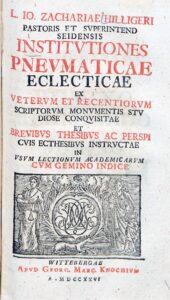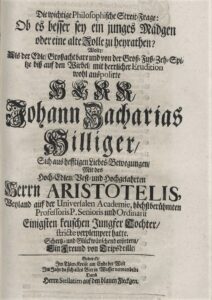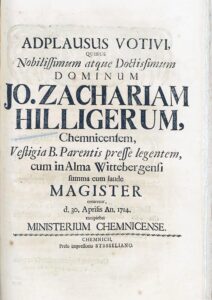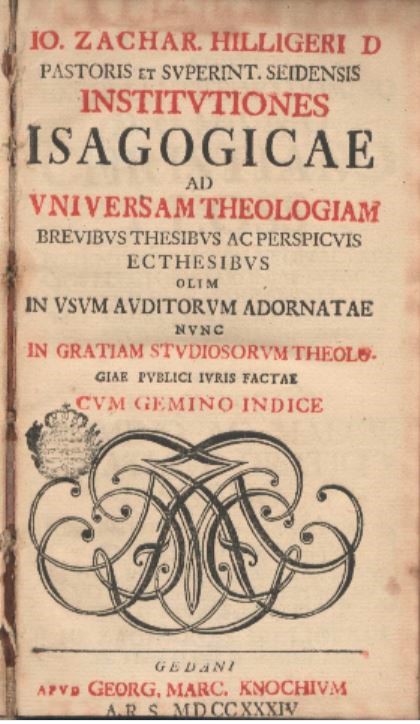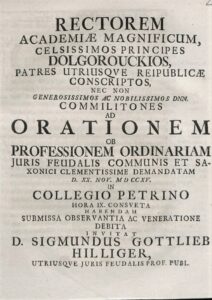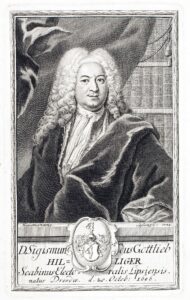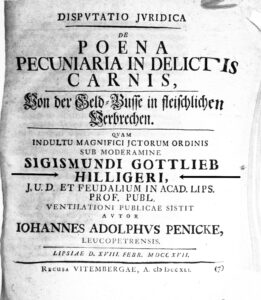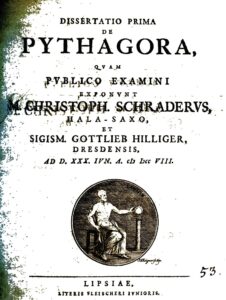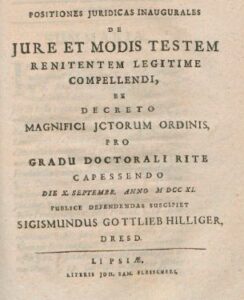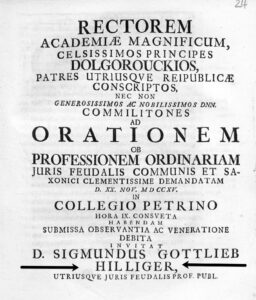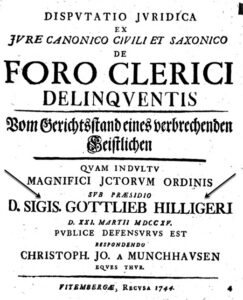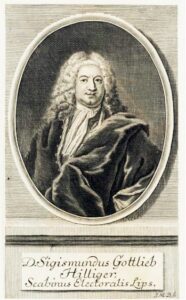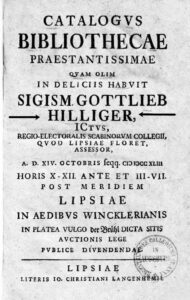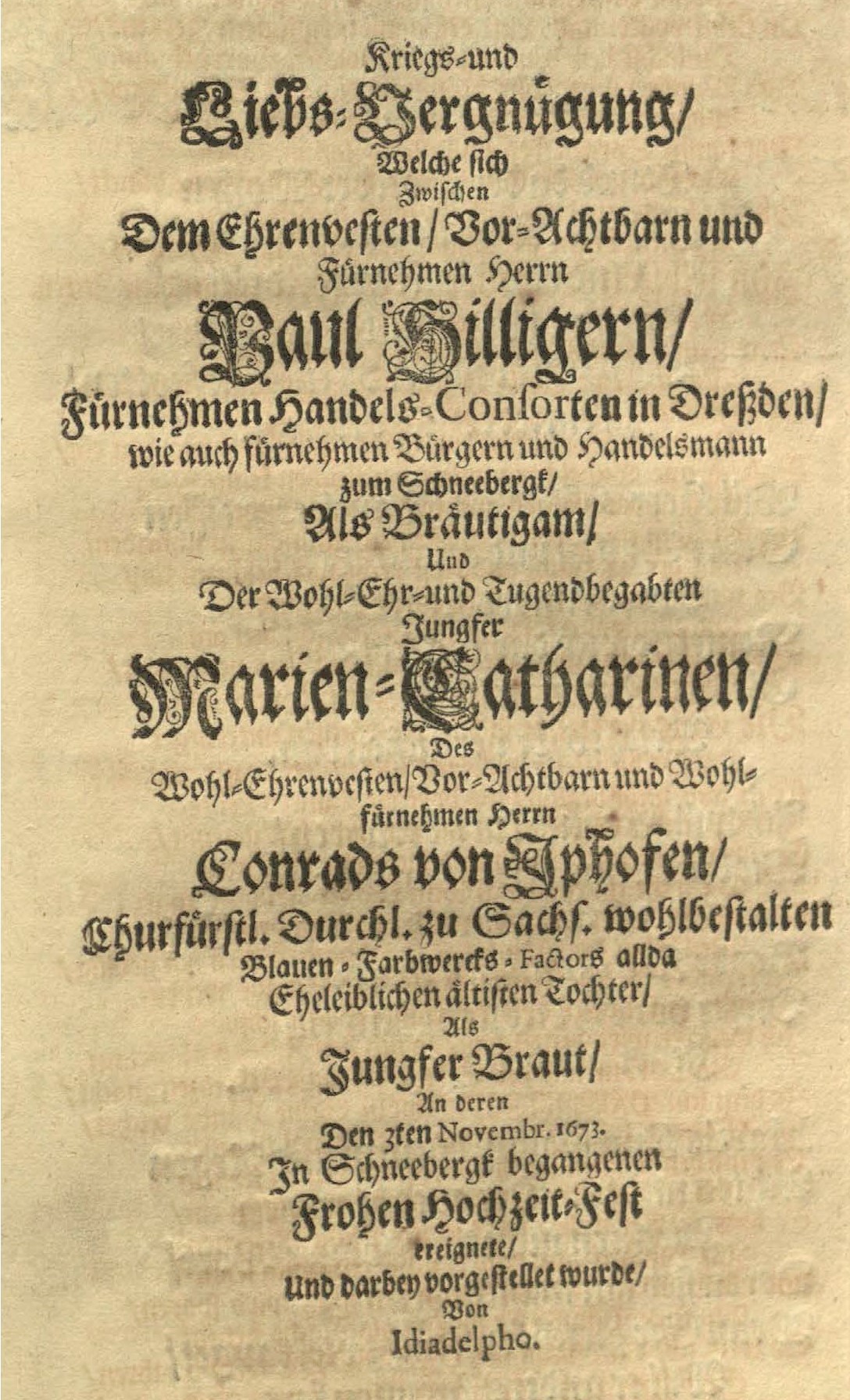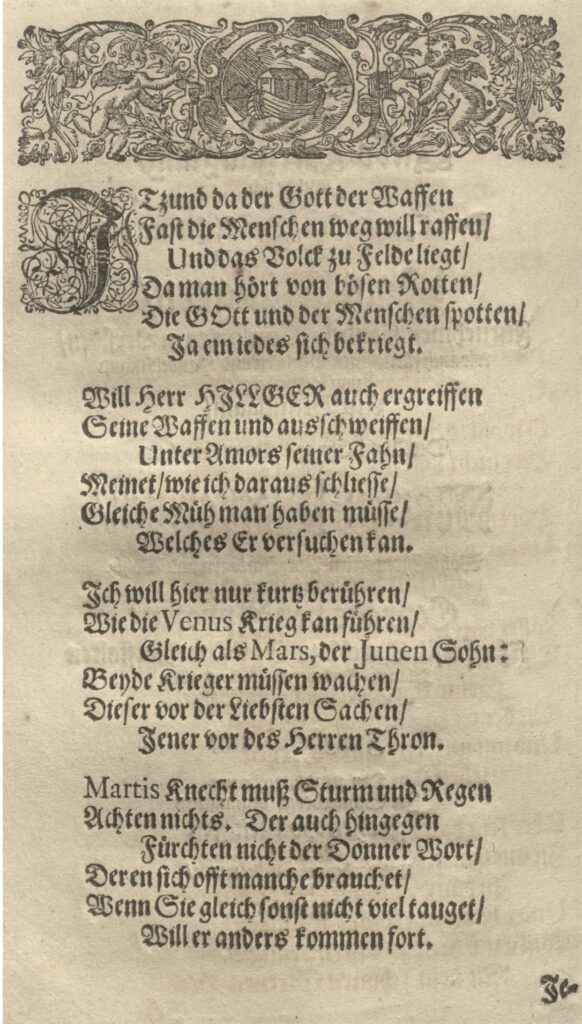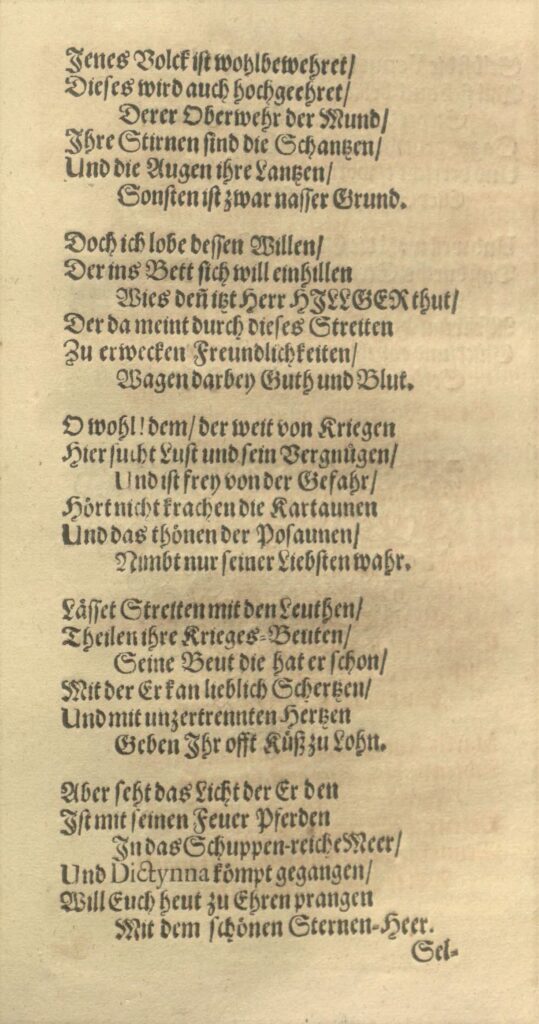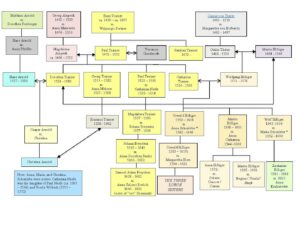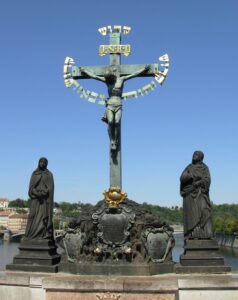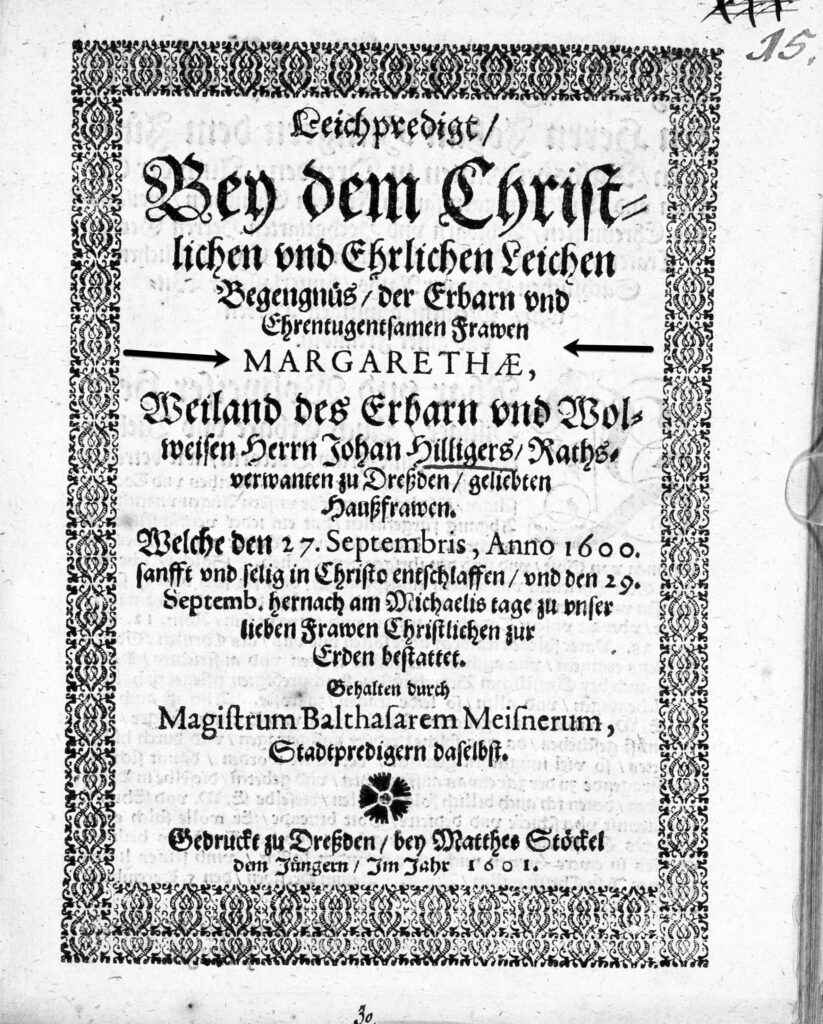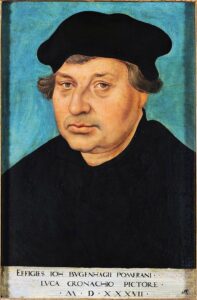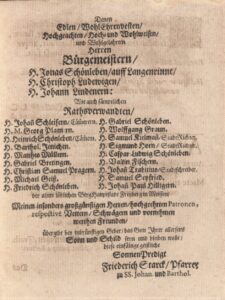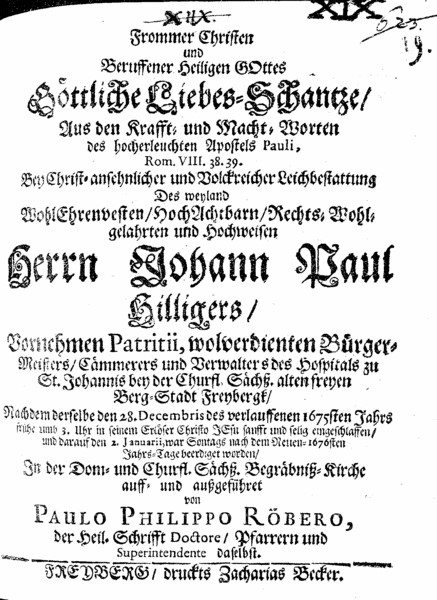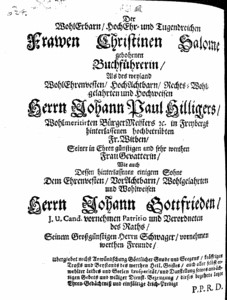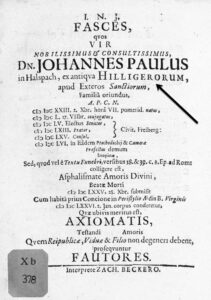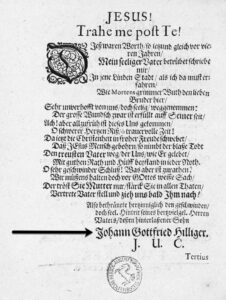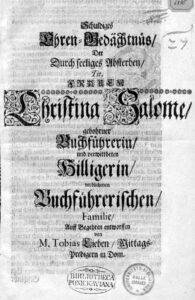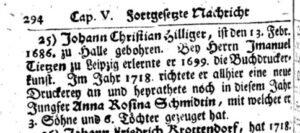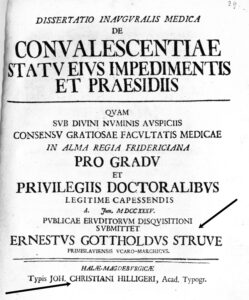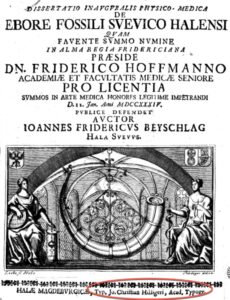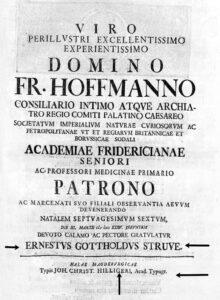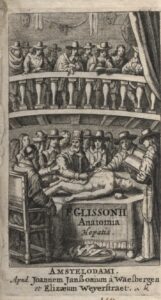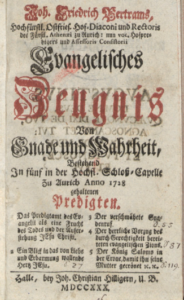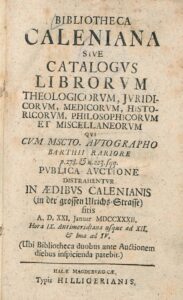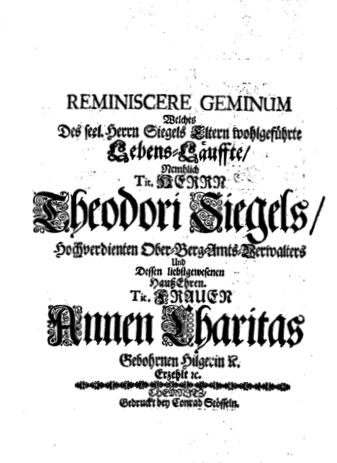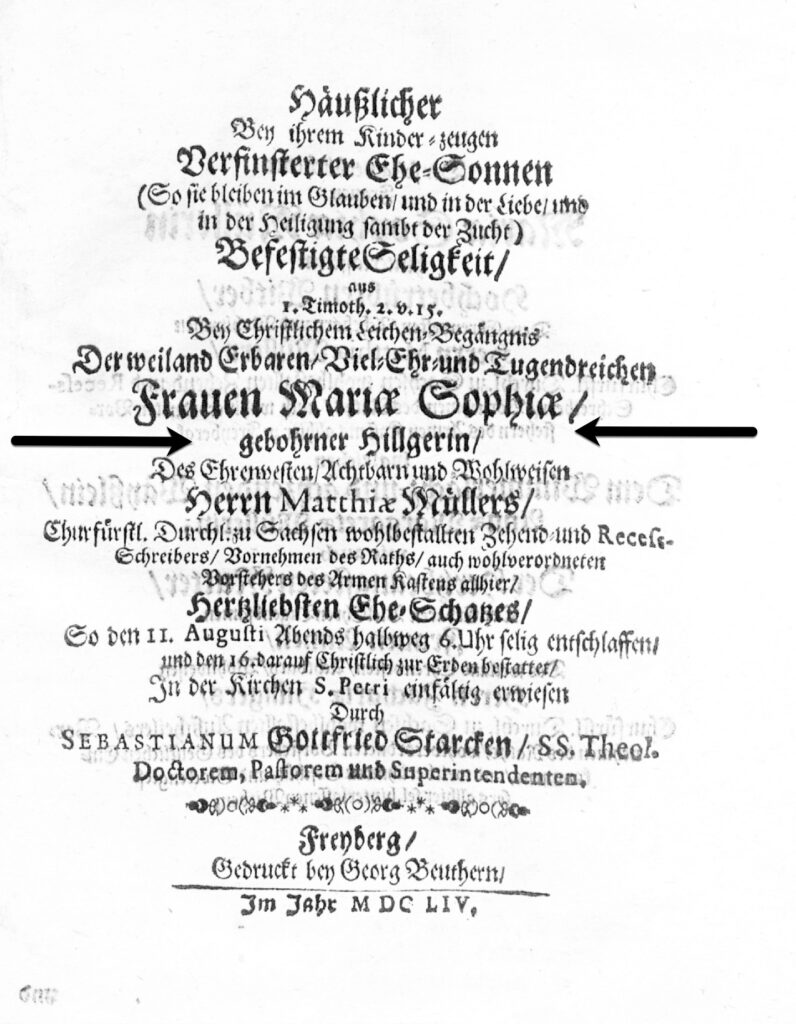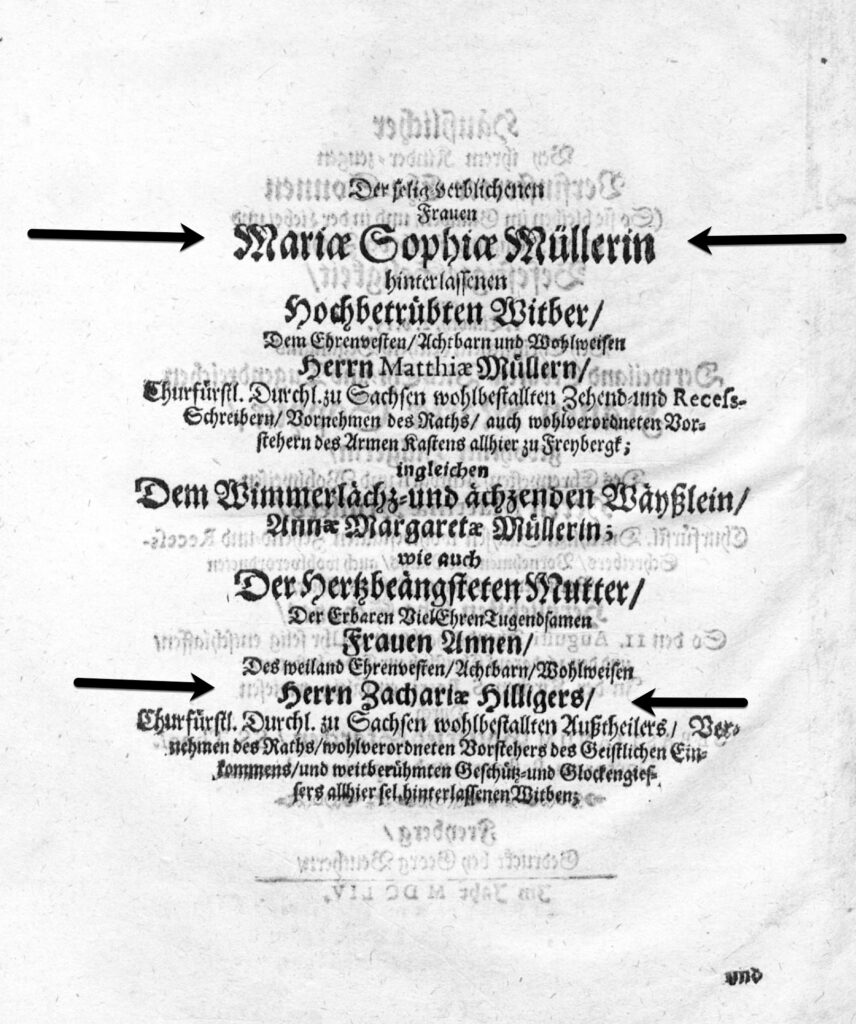The Hilliger family … This page is very much under construction … There are a number of ‘Oswald Hilligers’ which makes following the story a bit of a challenge.
Oswald Hilliger (1550 – 1609/10) = Ann Schönleben (1562 – 1646) >> Oswald Hilliger (1583 – 1619) = 1614 = Margarethe Horn (1594 – 1622) >> Barbara Hilliger (1618 – 1663) = 1645 = Burchard Berlich (1603 – 1670) >> Susannah Berlich = George Adam Struve >>>>> The Three Loeck Sisters.
The entire Hilliger family was described in the 1906 Mitteilungen des Freiberger which can be read HERE in PDF (in German). Likewise Das Hilliger´sche Epitaph in der Thomaskirche zu Leipzig In: Neues Archiv für Sächsische, Geschichte 3,86, XVI 526.
The family, which at the beginning of its history also called itself Kannegießer, has been traceable in Freiberg in Saxony since the 14th century. The family established a number of iron foundries in and around Freiberg and dominated the field of bell casting and cannon manufacture for over three hundred years. The family has been briefly described on Wikipedia.
The earliest Hilliger family member who has been identified is Hans (around 1350 – 1420), and the oldest Hilliger bells in St. Michaelis (1408) and Burkersdorf (1415) can be attributed to him. This Hans (also Hannus Hilling, Hans Kanngießer), was the owner of the first foundry in the Petersviertel in Freiberg from 1412 to 1420. His sons Hans (1420 – 1471) and Nicol (mentioned 1435 – 1481) continued as bell and piece casters in Freiberg. However, their bell castings for the Freiberg city churches were lost in the city fires of 1471 and 1484.
The son of Nicol, Oswald (around 1450–1517), built the family’s second foundry in 1482 and delivered bells to Saxony, Thuringia, and Bohemia.
His sons Martin and Andreas (around 1486 – after 1560), as well as Martin’s sons Wolfgang (1511 – 1576) and Oswald (1518 – 1546), continued in the trade. Of Martin it is said that “ …. he usually went to the armory once or three times a day; Didn’t allow to suffer that there was one piece of dust on the books, but rather wiped them over with his own cap or coat, so that everything had to be clean and glistening. He was particularly inclined to the craftspeople whom he frequently visited in their workshops, alone with a servant and the boy, who was a Moor, and an English dog.”
Wolfgang married Catherina Trainer, the daughter of Paul Trainer and Magdalena Alnpeck, in 1536, (and were the ancestors of The Three Loeck sisters). The places where they worked included: Freiberg, Dresden, Breslau, and Stettin. More than 100 bells from Wolfgang and Oswald’s workshops can be identified, including the large bells in Freiberg Cathedral with 4570 kg, in the Petrikirche in Freiberg with 3790 kg, in the Marienkirche in Borna with 2250 kg and in the Nikolaikirche in Freiberg with 2050 kg. These bells are characterized by a very carefully crafted bell decoration.
Wolfgang cast not only bells, but also artillery, grave slabs and sepulchral sculptures, many of which were commissioned by the princes of central and northern Germany. He rose rapidly in civic society to become one of Freiberg’s richest citizens and was regularly elected mayor of Freiberg from 1557.
As a skilled metal caster capable of producing masterpieces of artillery Hilliger worked for the Margrave of Küstrin, the Dukes in Pomerania, the Dukes of Weimar, Duke William the Younger of Brunswick-Lüneburg, and the Margrave of Brandenburg. In 1567 Augustus the Elector of Saxony appointed Hilliger as his chief metal caster at Dresden where he produced guns with ornaments, coats of arms, and inscriptions. Hilliger’s foundry produced the grave stone for the Duchess Catherine ( † 1561) and probably also those of other princes in the crypt of the Freiberg Cathedral. Hilliger advanced methods of metal casting as well as producing diverse works not only bells but all kinds of artillery pieces.

In order to transport the huge metal piece from Freiberg to Wolgast ships were used to cross the Elbe to Hamburg and then probably continuing across the Baltic Sea.
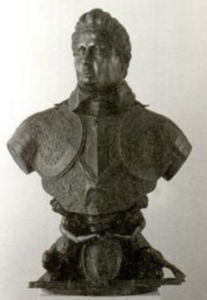
Wolfgang (1511 – 1576), and his brother Oswald (1518 – 1546), set new standards for the performance of casting when they produced the extraordinary Luther plaque (1545) for the first reformed church in the castle chapel in Torgau. Wolfgang Hilliger, was also a City Councilor of Freiberg for 30 years, including 20 years as mayor. With his wife Catherine Trainer he had 10 children and 28 grand children and 3 great grand children. Wolfgang died on the last day of November in 1576, when he was 65 years old, at three o’clock in the morning, just at the hour in which he was born and j\he was buried in the Peterſkirche on December 2nd.
On Wolfgang’s death a commemorative bell was cast which included the following elements: On the shoulder a narrow line of writing bordered by two bars with a quotation from the Bible:
SIT NOMEN DOMINI BE[N]EDICTVMa) EX HOC NVNC ET VSQVE IN SECVLVM1) ANNO DO(MINI)b) · M · D · LIX · / WOLF HIGERc) CZV FREIBERGKd) GOS MICH
And the year in raised letters. Underneath is a broad frieze of a frequently repeated, symmetrical tendril ornament with flowers. Below the year is a large, triple-framed medallion with a circumferential foundry mark in raised letters, which begins at the apex of the medallion. A full coat of arms in the inner field is shown that had been in the family’s hands since 1521. Three footbridges on the Wolm.
However Wolfgang’s son Oswald (1550 – 1610) broke away from the family’s iron casting tradition and became exclusively an alderman and city councilor of Freiburg.
Wolfgang (September 6th, 1545 – April 4th, 1614) took over the Freiberg foundry after the death of his father. The bell that he cast for St. Bartholomew in Waldenburg deserves special attention:
Upon Wolfgang’s death in 1614 a funeral sermon was published: Der trostreiche Gnaden-Spruch Christi, Joh. 3. Cap. Also hat Gott die Welt geliebet, [et]c. Bey dem Volckreichen Leichbegengnüß, Des … Wolffgang Hilligers, … So den 4. Aprilis, dieses 1614. Jahres … seliglich entschlaffen, Vnd folgendes den 8. Aprilis, … zur Erden bestattet vnd geleget worden … . The funeral sermon includes an anecdote that he read the Bible through from beginning to end more than a hundred times and: “It is almost unbelievable and yet true, in that he always claimed that the day when he started was exactly a year to the day when he finished the Bible”.
The family was also responsible for casting bells for the following churches (among others):
- St. Peter and Paul on September 26th, 1560 in Görlitz (lost in the church fire in 1690);
- The Maria Memorial Bell of the Dresden Frauenkirche (1518);
- The triple ring of the Naumburg City Church St. Wenceslas (1518);
- The chiming bell for the St. Thomas Church in Leipzig (1539, lost on December 22nd, 1943);
- The bell in the watchtower of Geyer (1539) with a weight of 3500 kg;
- The bell for Trinity Church in Lauban (1560);
- In 1521, on behalf of Cardinal Albrecht von Brandenburg, the family cast the no longer existing bell for the new monastery in Halle (120 quintals, 6000 kg) for which in 1521, Martin Hilliger received a coat of arms (white bear on a red field with a gold caliper in its paws).
The family not only cast bells for churches and cathedrals, but also a considerable number of artillery pieces [God and Guns] for the Saxon dukes Georg and Heinrich, as well as grave slabs for members of the Albertine ducal family.

The son of Wolfgang (1511 – 1576) was the city councilor Oswald Hilliger(1550 – 1610) who married Anna Schönlebe (*1562 in Freiberg; † 6. March 1646), daughter of Freiberger Oberhütte manager Michael Schönlebe (1523 – 1588) and his wife Walpurgis Hanel. They had at least one son, another Oswald (1583 – 1619), whose life is quite well known and, being the direct ancestor of the Three Loeck Sisters, we shall explore further below.
Of the city councilor Oswald his funeral sermon book says this of him: ‘He never appeared to have practiced his father’s occupation, but rather was used by the family firm as an accountant in some of its businesses. His favorite occupation was studying the law, and he preferred associating with learned men over anything else. In 1582 he was as a senator of the city council, supervising the licensing of grinding and water mills, lime kilns, logging timber and rafts. In April 1593 he was elected a city judge, which office he performed alternately until his death. He was also often entrusted with important city matters by the council.‘ The funeral sermon goes on to say that although he was a city judge, he renounced the death sentence over “evildoers” as he was always very determined that it should be justified, and he often said to a friend that he was always afraid and worried about such things as it would affect the life and limb of the individual. He was a friendly and compassionate person, and was especially benevolent towards the poor. ,
When Oswald the city councilor died in 1610 a funeral book was published titled: Christus Via, Veritas & Vita. Johan: XIIII …
Oswald (1583 – 1619) attended school in Freiberg, studied in 1601 at the University of Leipzig, and in1602 at the Universities of Wittenberg and Jena, where in 1606 he obtained his doctorate in law. He then undertook the then usual custom of a study tour which led him through various German universities where he studied the local variations of the Law. In 1616 he received at Jena University a professorship which was also associated with an appointment as the assessor of the Princely Saxon Schöppeustuhl in Jena.
On his appointment as a faculty member a book celebrating his achievement was published with the title: Viro Clarißimo Osvaldo Hilligero Fribergensi Misnico Supremam in Utroq[ue] Jure Lauream, quam Docturam vocant die 26. Octobr. 1609. Collatam Gratulantur fautores & Amici.
On 8th March, 1614, Oswald married Margarethe Horn in Freiberg, She was the daughter of Nicolaus Horn (* 04.01.1554 in Freiberg + 08.04.1615 in Dresden) who was an alderman and councilor in Freiberg and his wife Barbara Nitzsche (1579-1617). To mark the occasion a wedding book was published under the title: Festivitati Nuptiarum Clarissimi Et Excellentissimi Viri, Dn. Osvaldi Hilligeri … & Lectissimae Et Pudicissimae Virginis Margaretae, Viri … Nicolai Horns … filiae … : Ad 8. diem Martii Faventiae observantiae tesandae ergo Congratulantur …
There is much confusion among internet genealogists as to who the father of Margarethe (Horn) Hilliger was. One well known site has him as a Martin Horn and many do not mention him at all but most of the 19th century family history books are definitive in Nicolas Horn being her father.
For example, the entry for Oswald Hilliger in a major history of Freiberg has the following:
From his wife Margarethe, née Horn, a daughter of Councilor Nicol Horn in Freiberg and Barbara, née Nitsche, daughter of Councilor Peter Nitßsche, he had three children:
1. Christian † young.
2. Friedrich, † young.
3. Barbara, she married i) Nicol Helfreich, Electoral Court and Justice advisor and ii) and 19 Dec.1645 Burchard Berlich, inheritance, feudal and court lords of Wegefarth, Braunsdorf and Waltersdorf, Elector of Saxony. Councilor († August 1, 1670), from which marriage she had 11 children.
After Oswald Hilliger’s death, his widow Margarethe, née Horn, married Professor Ortolph Fomann on September 11, 1620 in Jena.
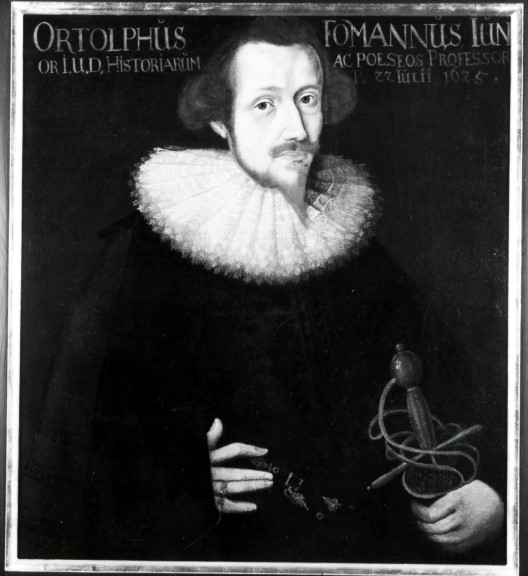
Christoph Cranach, the son of Lukas Cranach (1515-1586) and Magdalena Schurff (1531-1606) died in 1596 and his widow Veronica remarried on 8th March 1603 Godfrey Hempel. The wedding book was titled: Gamēlia Ornatissimo & L.L. studiosissimo, Dn. Godefrido Hempelio Fribergensi … and one of the contributors was Oswald Hilliger, as shown below left. Below right, Oswald Hilliger’s contribution to: Quaeres bene vortat. Illustrißimo, Celsißimoq[ue] Principe ac Domino, D. Johanne Ernesto, Duce Saxoniae, Landgravio Thuringiae … Ambrosio Reudenio …
His publications were numerous and we only give a few examples of his output here. For instance, in 1608 he published: Miscellaneanearum Iuris Controversi Quaestionum Decades Tres …. And, in 1610, the first part of Donellus Enucleatus Sive Commentarii Hugonis Donelli de Iure Civili in Compendium ita redacti ut verum nucleum contineant
When he became a professor at Jenna in 1616 he was especially praised for the fact that he never disagreed or argued with his colleagues, and he had a “very benevolent and gentle heart”. For example, before he died, he paid 200 Meissner Guilders to the ministry at Jena to improve the pay of the two deacons.
He died on the 25th of March 1619, and was buried on the 29th; he was only 36 years old. The sermon published to mark the occasion (Druckausg.: Leich und Gedächtnißpredigt Des … Herrn Oswaldi Hilligeri…) included a description of him being a scholarly, just, and sincere man, full of wisdom and having lived an unsullied life. Another funeral sermon (below) was titled: Oratio funebris in honorem ac memoriam … Oswaldi Hilligeri …
In 1609, Ortolph Fomann, Jnr. was appointed to the law faculty of the University Jena, an appointment that was signed off by Oswald Hilliger. Decanus Facultatis Iuridicae Ortolphus Foman. U.I.D. Et Professor, Iurisprudentiae Navantibus Operam S. D. When Oswald died in 1619 his widow, Margarethe (Horn) was aged 26, and she went on to marry Ortolph Fomann (Jnr.), although she only lived a few years after. Ortolph then married Dorothea Susanna Arumaeus, the daughter of Dominicus Arumaeus.
Margaretha Hilliger (1592 – 1633) was born June 4th 1592 in Freiberg, Saxony and was the sister of the above Oswald and the daughter of Oswald Hilliger senior and his wife Anna Schönlebe. On 27th October 1612 Margaretha Hilliger married Peter Theodoricus (see chart).
A wedding book titled Honori Ac Festivitati Secundarum Nuptiarum … Petri Theodorici … Cum … Margaretha … Osvaldi Hilligeri … relicta Filiâ … gratulantur amici was published which included a contribution by her brother Oswald (below left). It also included a note of thanks by Peter to his friends and his “abandoned” children. This, along with other evidence, indicates that Peter had been previously married and his first wife had died leaving children behind; as was so often the case during these times.
Another wedding book was published under the title: Gamēlia In Solennitatem Nuptiarum … D. Petri Theodorici I.U.D. Professoris Publici … In Academia Ienensi, Sponsi: Et Margarethae, Viri … Dn. Oswaldi Hilgeri, Quondam Senatoris & Iudicis Oppidani in … It also included a contribution by Georg Mylius (right).
In 1616 a daughter – Anna Margaretha – died but whether this was a daughter by Peter’s first marriage or by his second to Margaretha Hilliger it is not possible to say. Typical of the day, the mother’s name is omitted from the child’s funeral sermon, and although this was not always the case, it is here. The title of the funeral sermon is: Sion Relicta, Das ist Das verlassene Zion/ Erkläret … Bey Christlicher Leichbestattung Annae Margarethae, Des … Herrn Petri Theodorici J. U. D. Profess: publici, und des … Schöppenstuels zu Jehna/ Assessoris, viel geliebten Töchterleins/ welches den 20. Januar. … 1616. … entschlaffen/ und den 22. Christlich zur Erden bestattet worden
When Margaretha Hilliger died 1633 a funeral sermon book was published: Einfeltige und Christliche Ehrn und Leichpredigt Uber den schleunigen und unverhofften tödtlichen Abgang Der … Frawen Margarethen Gebornen Hilligerin/ Des … Herrn Petri Theodorici, uff grossen Löbichau beyder Rechten Doctoris … gewesenen Ehelichen Hausfrawen. Welche den 2. Octob. A. 1633. … entschlaffen und folgends den 3. huius … bestattet worden; which tells us that her death was: ‘ … rapid and unexpected … on the 2nd October 1633 … and then on the 3rd she was buried.’
CHRISTIAN HILLIGER
We are not exactly sure where this Christian Hilliger fits into the genealogy of Oswald Hilliger but a publication issued by Christian in 1625 appears to claim the above Oswald as his father. Witness this Gregorian chant (below) which was written to praise and congratulate the: ” … honorary venerable great gentleman and highly educated Mr. Oswald Hilliger” Doctor and Professor at Jena by his “blessed married son” Christian Hilliger, who administers the school episcopate with praise and honor on the 31st March Anno 1625. But why more than 6 years after the fact of his father’s death in 1619? There was another Christian Hilliger (1682 – 1657) who was the brother of Oswald the law professor.
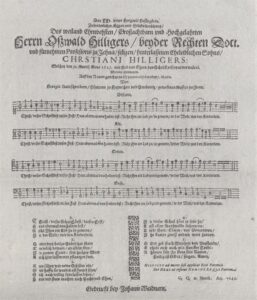
Das XXv. newe Gregorii Gesänglein. Zu sonderlichen Ehren und Glückwündschung/ Des weiland Ehrnvehsten/ Großachtbarn und Hochgelahrten Herrn Oszwald Hilligers/ beyder Rechten Doct. und fürnehmen Professoris zu Jehna/ seligen hinterlassenen Eheleiblichen Sohns/ Christiani Hilligers Welcher den 31. Martij Anno 1625. mit Lob und Ehren das SchulEpiscopat verwaltet ; Mit vier Stimmen. Auff den Namen gerichtet in Hypomixolydio oder 7. Modo
Not satisficed with just one Gregorian chant in honor of Oswald, Christian in the same year went on to produce another titled; Gratulatio Ad Christianum Hilligerum, Amplißimi, Clarißimi & Consultißimi Viri, Dn. Oswaldi Hilligeri … p.m. relictum filiolum : Cum ad celebranda Sacra Gregoriana more maiorum Episcopatu Scholastico Prid. Calend. April. bono omine fungeretur … 1625. And in 1632 he contributed a short poem to the memory of Peter Theodericus: Tertii Rectoratus Ienensis, Collati Viro Magnifico … Dn. Petro Theodorico …
Sebastian Hilliger (1553 – 1631). He was the brother of The Three Loeck Sisters direct ancestor Oswald Hilliger, the father of Zacharias, and grandfather of Johann Wilhelm. He was elected to the Chemnitz City Council in 1587, he became mayor for the first time in 1610 and was elected eight times as mayor thereafter. Enduring health was a big part of the joy of hid life. Little burdened with diseases, he died at the age of 79 years, still active and able to attend church and the town hall.
The orations to his memory delivered at his funeral were later published as the title page below indicates and appear on the GESA catalogue. De Vitae Humanae Termino Von dem Ziel des menschlichen Lebens …which tells us that: “ … his blessed soul was taken to himself [God] on Monday 7th March before noon between 8 and 9 o’ clock and his faded body was taken on Thursday the 10th of the same month in the year Anno 1631 to a Christian and honest resting place in the church of St. Jacob in Chemnitz.”
Zacharias Hilliger (* July 14, 1591; † 10 July 1654 in Chemnitz)- son of the above Sebastian and first cousin of The Three Loeck Sisters direct ancestor. He started out as master draper and later became mayor of Chemnitz, like his father. He married Magdalena von Berg (born July 17, 1611 Chemnitz, † December 14, 1669), the daughter of Caspar von Berg (s) and his wife Catherine (née Müller from Stolberg).
During the Thirty Years War the city of Chemnitz was ordered on March 1, 1633, to supply the army at Zwickau with 6 barrels of beer, 4 cattle, 4 calves, and 2000 pounds of bread, an impossible task for Chemniß as the city had by then been completely devastated by fire as well as the plague. However, Zacharias Neefe and Zacharias Hilliger went to Zwickau on March 16 with at least 6 kegs of beer, 1500 pounds of bread and 30 thalers for cattle which was deemed satisfactory by the army there. In 1640, when Chemnitz was besieged by the Prince of Florence, Zacharias was sent to the enemy general together with Melchior Straube, Johann Plattner and the pastor of St. Johannis, to negotiate with him for the sake of the city.
Pages from his funeral sermon (Fidelim & piorum Christianorum refectorium … ) are shown below:
When his daughter Regina married the Chemnitz merchant Johannis Barthmann on 26th September 1638, a wedding poem was penned to celebrate the occasion under the title: Applausus Poeticus In Festivitatem Nuptialem Eximii, Pietate & morum Integritate Praestantißimi … Dn. Johannis Barthmanni, Mercatoris praecipui, ….
Johann Wilhelm Hilliger (* 3rd August 1643 in Chemnitz; † 9. September 1705 Ebenda) son of the above Zacharias Hilliger and Magdalena von Berg, the daughter of Caspar von Berg and Ursula von Schonfeld. He spent his childhood and early years of schooling in his hometown of Chemnitz. At the age of 11 years his father died, so funded by a grant from the City Council of Chemnitz, he entered the University of Wittenberg on 26 September 1664, where he primarily devoted himself to a study of oriental languages. After he obtained his Masters on 15th October 1667, he was granted another scholarship by the Chemnitz City Council.
He was offered several Rectorships in places other than in Chemnitz, such as Reval, Lübeck and Zwickau, but he refused. Instead, he gave, on 3rd December 1676, at the invitation of Chemnitz Council, a guest sermon for the diaconate of St. Jakobi church. The Chemnitz Council was pleased with his sermon and confirmed him as a deacon. Therefore, he went to Dresden, where he finished his theological examination and was ordained for the office. He then appeared on 24 December of the same year at his office. On September 9, 1684 he was made archdeacon and after Albinus Seyfried died, he was given the superintendency of Chemnitz. This he accepted on 5 December 1686. On August 11, 1687 Philipp Spener ceremoniously introduced. Johann Wilhelm to the Saxon court as its preacher.
Hilliger was a prolific scholar and over 800 students were said to have attended his lectures during his tenure at Wittenberg University. His publication output includes about 49 different titles under his own name. For example in 1676 he published: ‘S°emãlôt Yi’srãēl b°e-midbãr Seu Vestimenta Israelitarum In Deserto Ex Devter. VIII. 4. it. XXIX. 5. Et Nehem. IX. 21.
He married Anna Elisabeth Egerland on 27 February 1677, the daughter of fort captain Erasmus Egerland and Anna Katharina Notnagel (born December 15, 1637 in Wittenberg; † September 1672). Anna Katharina was the daughter of Christoph Notnagel. Anna Katharina Notnagel married on November 14, 1654 with the Wittenberg city commander and widower Erasmus von Egerland († October 1667 in Wittenberg). There is evidence in the bibliographic record that Egerland’s first wife was Anna Riebstein whose funeral sermon book was titled: Antidotum Mortis oder Ein Kräfftiges bewehrtes mittel wieder den Todt … Bey … Leichbegängnüß Der … Frawen Anna Riebsteinin deß … Herrn Eraßmi Egerlandes … which states that Anna died “on March 28th in the year 1654 at the age of 54 and was buried on 2nd April … ” The title page of this funeral sermon is shown below:
When Johann Wilhelm Hilliger married Anna Elisabeth Egerland a number of wedding books were published to mark the occasion such as: Solennibus Nuptiis Viri Admodum Reverendi, atq[ue] Praecellentissi,i Dn. M. Joh. Wilhelmi Hilligeri … and Character Amoris Nuptiis Viri … DN. M. Joh. Wilhelmi Hilligeri, … Cum … Anna Elisabetha Egerlandia, Sponsa … and Gratiae Maritales Connubiali Solenitati Inlyti Neonymphorum ParisViri Admodum Reverendi Et Praecellentis …
Among Johann Wilhelm’s published works were: in 1669, Sive Cryptographian ex Dan. V, 25 – 28. Indultu Superiorum, In celeberrima ad Albim Academia Publicae philologuntōn exetasei … which celebrates “ … the most famous of the Elbe State University philologist.” In 1679, Johann Wilhelm wrote: Johannis Wilhelmi Hilligeri … sive summarium lingvæ Aramææ, i.e. Chaldæo-Syro-Samaritanæ … In 1695, Contribution vor Priester-Wittwen und Waysen Kemnitzischer Superintendentur, bestehende in XV. Articulis, so Anno 1581 abgefasset und Anno 1690 … beym gehaltenen Synodo … verbessert …
In 1673, […] sive Bileamus Eiusdemque Asina Loquens, ex Numer. XXII, 21-33.
Johann Wilhelm died from a painful gout on 9th September 1706. A funeral sermon book was published some years later: Der Werthgehaltene, auch erwünscht- und seelige Todt der Heiligen, Als Der … Herr M. Johann Willhelm Hilliger, Vornehmer und weitberühmter Theologus und Linguiste … den 9. Sept. 1706. Seines … Dienstes gnädigst erlassen … Und … Mit einer Trauer- und Gedächtniß-Predigt … beehret worden …
Sidonie Hilliger (* ? – 1689) was the daughter of Zacharias Hilliger (1591 – 1654) and Magdalena von Berg and sister of Johann Wilhelm Hilliger. She married Georg Engelmann.
Johann Wilhelm had two sons: Johann Sebastian Hilliger (* 26. Mai 1695 in Chemnitz; † 31. October 1755 ebenda) and Johann Zacharias Hilliger (1693 – 1770) They wrote two “letters” in 1714: Fratem ex animo totum Johannem Sebastianum Hilligerum Phil. Stud ??? Frater intimiori cordis affectu colende : [Dabantur Lipsiæ d. 30. Aprilis A. R. S. MDCCIV.] And, Frater intimiori cordis affectu colende: [Dabantur Lipsiæ d. 30. Aprilis A. R. S. MDCCIV.] [Fratem ex animo totum Johannem Sebastianum Hilligerum Phil. Stud.]
Johann Wilhelm had a daughter, Johanna Dorothea, who married Mauritius / Moritz / Maurice Engel (1673 – 1741) in 1698. They had the following children: Moritz Adolph, Moritz August, (1713- ), Moritz Dorotheus (1717-1786) and Moritz Friedrich (1701-1771). Moritz Engel published: Diss. pol. de prudentia peregrinandi … and in 1696 De Suppliciis Haereticorum, Sub Praesidio ...
JOHANN ZACHARIAS HILLIGER (1693 – 1770). He was the first son after five daughters of the above Superintendent Johann Wilhelm Hilliger (1643-1705) and his wife Anna Elisabeth Ergerland (1658 -1725).
On 29th October 1725 Johann Zacharias married Johanna Christiana Juliane, the daughter of Georg Wilhelm Kirchmaier. From this marriage there were 9 children: 3 sons and 6 daughters.

Johann Zacharias Hilliger
His father took special care of his education and he began to receive private tuition at the age of eight years. After the early death of his father in 1706, he studied for eleven years at the Chemnitz public school. In 1710 he entered the University of Leipzig, where he first graduated in philosophy. On October 17, 1713, he entered the University of Wittenberg, where he resided with his wife’s cousin Georg Wilhelm Kirchmaier and on 30th April 1714 he received his Masters in liberal arts – Als der Edle, und Wohlgelahrte Herr Joh. Zacharias Hilliger, von … which included a contribution by Moritz Engel.
Among Johann Zacharias’s many publications were:
At Wittenberg he began to lecture in the Faculty of Arts. In 1724, he was appointed to a professorship in philosophy and in the summer of the same year he was made Dean of Arts. On 29th August he was ordained at Wittenberg but in order to fulfill this office he obtained his licentiate in theology and doctorate of theology on 17th April 1727. In 1740 he was offered a theological professorship at Wittenberg Academy where he remained until his death in 1770.
SIEGMUND GOTTLIEB HILLIGER (1686 – 1743) also Sigesmund or Sigismund. He was the son of Sigismund Hilliger (1648 – 1726) and Eva Maria Klemm (1652 – ) and the grandson of Oswald and Sibyla (Trainer) Hilliger. He was a jurist in Dresden.
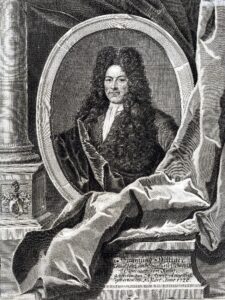
In 1742 he supervised: Dispvtatio Jvridica, De Poena Pecuniaria In Delictis Carnis … And, Dissertatio prima de Pythagora, quam … examini exponunt M.C. Schrader … et S.G. Hilliger, etc.

After he died in 1743 his book collection was put up for auction: Catalogus bibliothecae praestantissimae quam olim in deliciis habuit Sigism. Gottlieb Hilliger … 1743.
Paul Hilliger (1646 – 1708) was the son of Oswald Hilliger (1619 – 1680) and Sybille Trainer (1622 – 1658) and brother of the above Siegmund. On 3rd November 1673 he married Maria Catharina, the daughter of Conrad von Iphofen. For the occasion a wedding book was published titled: Kriegs und Liebs-Vergnügung, Welche sich Zwischen Dem … Herrn Paul Hilligern, Fürnehmen Handels-Consorten in Dreßden …
The Hilliger – Uthmann Connection
Martin II. Hilliger (* 1538; † September 5, 1601 in Dresden) married Anna Uthmann (* 1544 in Annaberg / Saxony; † August 1, 1608 in Dresden). Anna was the daughter of the mountain gentleman and trader Christoph Uthmann (1507–1553) and his wife Barbara, born von Elterlein (1514–1575). They had a son Johannes Hilliger (~ February 8, 1567 in Freiberg / Saxony; † April 24, 1640 in Dresden) who was mayor of the city of Dresden in the period from 1614 until 1638 (see below).

(1514–1575) whose daughter Anna married Martin Hilliger
The Hilliger – Cracow / Cracau Connection
There are two Hilliger – Cracow marriages. One was between Anna Hilliger and Johann Cracow. He died young and her second marriage was to the electoral councilor and secret chamber secretary in Dresden, Ludwig Wilhelm Moser († 1635). The other Cracow – Hilliger marriage was between Johannes Hilliger and Margarethe Cracow (* 1572; † September 28, 1600), daughter of the Electoral Saxon Privy Councilor Georg Cracow (1525–1575) and his wife Sara, born Bugenhagen (1525-1563). Her mother was Sara Bugenhagen, a daughter of Dr. Pomeranus Johannes Bugenhagen. The marriage was on October 10, 1592.
Hans / Johannes Hilliger was born on 8 February 1567 and baptized at the Church of St. Peter in Freiberg. the son of Martin II. Hilger (* 1538; † September 5, 1601 in Dresden) and his wife Anna Uthmann (* 1544 in Annaberg / Saxony; † August 1, 1608 in Dresden).
He first worked with his father Martin (1538 – 1601) to learn how to cast. After his father’s death, he took over the family business and was appointed the Elector of Saxony’s iron caster. From his workshop, several bells were cast for churches in the Dresden area, but also works of art including his most important creation – the Calvary group for the Charles Bridge in Prague – based on the work by the sculptor Wolf Ernst Brohn.
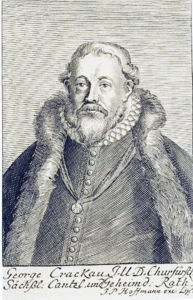
When Margarethe (Cracow) Hilliger died, a funeral sermon book was published Leichpredigt Bey dem Christlichen und Ehrlichen Leichen Begengnüs … [Funeral sermon for Margarethe, wife of Mr. Johan Hilliger councilor to Dreßden who fell asleep gently and blissfully in Christ on September 27th, Anno 1600, and who was on September 29th buried.
Johann Paul Hilliger (1623 – 1675) was the son of Jonas Hilliger (1593 – 1639) and Catherina Biener (1601 – 1623). He married, on 17th September 1650, Christina Salome Buchfuhrer (1630 – 1700).
In the year 1656 Johann Paul was listed among the city burgers of Freiberg who attended a service of celebration that included a great sermon delivered at the cathedral church and which was published under the title Sonne der Gerechtigkeit Christus Jesus Wie sie bey dem Auffgange der Menschwerdung Ihre 1. Goldgläntzende … (below left). Others who contributed included a number of inter-connected family members such as: Jonas Schönleben, Johann Lindener, Heinrich Schönleben, Christian Prager, Friedrich Schönleben, Sigmund Horn, Caspar Ludwig Schönleben, Samuel Seyfried, etc.
Upon Johann Paul’s death a funeral sermon book was published in 1676 under the title: Frommer Christen und Beruffener Heiligen Gottes Göttliche Liebes-Schantze … which describes him as a well-deserved citizen, master cameraman, and administrator of the hospital at St. Johannis who “fell asleep” on the 28th December of the past 1675 year and then on the 2nd January, was buried on the Sunday of the next year 1676.
A second funeral sermon: Fasces quos Vir Nobilissimus & Consultissimus, Dn. Johannes Paulus in Halspach, ex antiqua Hilligerorum … was published and included a number of contributions from family members such as Johann Gottfried Hilliger and Johann Friedrich Horn.
When Christina Salome (Buchfuhrer) Hilliger died a funeral sermon book was published under the title: Schuldiges Ehren-Gedächtnüs Der Durch seeliges Absterben Tit. Frauen Christina Salome gebohrner Buchführerin ….
Johann Christian Hilliger was born on Feb. 13, 1686 in Halle. Book publisher and printer. He learned the art of printing with Imanuel Tietzen in Leipzig in 1699. In 1718 he set up his own printing shop there and he married Anna Rosina Schmidt the same year with whom he fathered three sons and six daughters. Unfortunately, so far, we have been unable to establish where he fits on the Hilliger family tree. However, his profession as a book publisher meant that he interacted with various members of the Hilliger family described here as well as other families on this website.
Between approximately 1720 to 1740 he was responsible for publishing a large number of university dissertations from a number of universities such as those at Jenna and Halle.
In 1735, when Ernst Gotthold Struve submitted his dissertation for his medical degree with the title: Dissertatio inauguralis medica de convalescentiae … Johann Christian Hilliger was used as the publisher. Johann Christian also published a book by Ernest Gotthold Struve titled: Viro Perillvstri Excellentissimo Experientissimo Domino Fr. Hoffmanno …
Some of the other books printed and published by Johann Christian Hlliger include:
ANNA CHARITAS HILLIGER (1629 – 1676), the daughter of Zacharias Hilliger and Anna Krahwieder. She married Theodor Siegel 1617-1676. They had one son, August Siegel. A book in her memory was published under the title: Reminiscere Geminum : Welches Des seel. Herrn Siegels Eltern wohlgeführte Lebens-Läuffte Nemhlich Tit. Herrn Theodori Siegels Hochverdienten Ober-Berg-Amts-Verwalters Und Dessen liebstgewesenen HaußEhren. Tit. Frauen Annen Charitas Gebohrnen Hilgerin [et]c. Erzehlt [et]c. Siegel, August. – Chemnitz: Stössel, [ca. 1694]
Her funeral sermon book has yet to be digitized: Melydria Epitymbidia : Quêis Generis Sexusque sui Decus Intemeratum, Foeminam-Domi-portam Theophilon Annam Charitatem Natem Hilligeriam … Dn. Theodori Sigelii … Uxorem A.C. MDCXXIX. I. Octobr. in Lucem Editam … A.C. MDCLXXVI. III. Junii coelo redditam, Cum jam II. hujus Mensis & Anni, Habita Panegyri Funebri … suo in Solamen … Exornatam voluere Fautores Et Amici, &c Freibergae : Beckerianus, [ca. 1676]
August Siegel was born February 23, 1651, he died January 14, 1694, April 24, 1680 councilor. He married on June 15, 1680 Anna Elisabeth Horn, the daughter of Gottfried Horn.
Anna Charitas had a sister Maria Sophia (1625 – 1654). In 1653 she married Matthias Müller ( ? – 1665). When Maria Sophia died a funeral sermon book was published Häußlicher Bey ihrem Kinder-zeugen Verfinsterter Ehe-Sonnen (So sie bleiben im Glauben und in der Liebe/ und in der Heiligung sambt der Zucht) Befestigte Seligkeit/ aus I. Timoth. 2. v. 15. : Bey Christlichem Leichen-Begängnis Der … Frauen Mariae Sophiae gebohrner Hillgerin … From the title we learn that she died on Sunday August 11th and was buried on the 16th “Christianly in the earth in the church of S. Petri”.
